|
www.theradiohistorian.org
Copyright
2023 - John F. Schneider
& Associates, LLC
[Return
to Home Page]
(Click
on photos to enlarge)
NBC NEW
YORK:
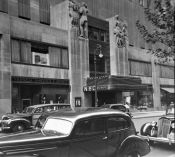
Façade of 30 Rockefeller Center
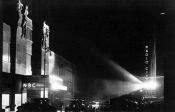
30 Rock on Opening Night (from a photo postcard)
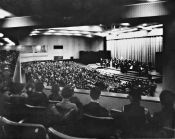
Studio 8-H, the ‘World’s Largest Radio Studio’, during a
broadcast of the Cities Service program, circa 1934 (NBC postcard)
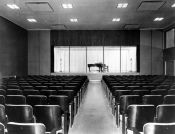
Radio City’s "Guild" Studio 8-G had a glass curtain that separated the
performer from the audience.
Studio 3A at Radio City
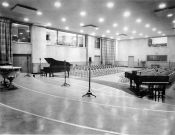
Studio 3B at Radio City
Master Control Room (colorized by the author)
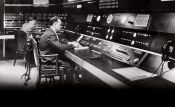
Another view of Master Control
A vertical cut-away floor plan, showing the
studio locations at 30 Rock.
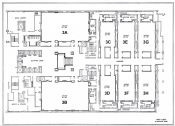
Floor Plans of Radio City in New York
NBC
CHICAGO:
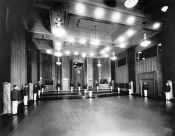
NBC’s giant Studio A in Merchandise Mart measured 32 x 47 feet.
The green décor was accented by the large bronze grill covering the
studio organ pipes. It was the home of such famous NBC programs
as ‘Fibber
McGee and Molly’, ‘The First Nighter’ and the ‘Carnation Contented Hour’
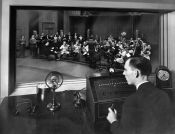
A studio control room at NBC's Merchandise Mart
studios in Chicago.
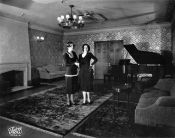
The "Library Studio" t NBC's Merchandise Mart studios in Chicago.
Master Control at NBC Chicago (colorized
by the author)
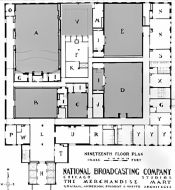
Floor plan of NBC's Merchandise Mart
studios
Click
HERE
to see more photos of NBC in Chicago.
NBC HOLLYWOOD:
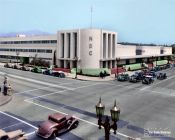
NBC’s Hollywood studio building, inaugurated
in 1938 (colorized from a picture postcard)”
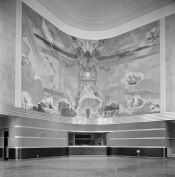
This giant mural greeted visitors in
the main lobby of Radio City in Hollywood.
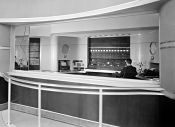
The master control desk was visible
through a window in the main lobby.
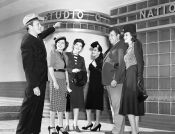
Jack Benny and other radio stars attend
the grand opening of NBC Radio City in Hollywood.
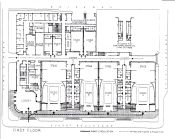
Floor plan of NBC's Hollywood studios.
CBS
COLUMBIA SQUARE:
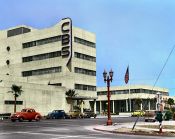
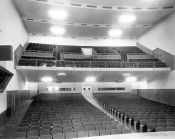
NBC SAN
FRANCISCO:
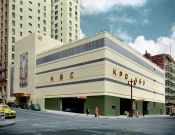
Click
HERE
to see more photos of Radio City in San Francisco.
|
|
NETWORK RADIO
Radio
broadcasting in the U.S. began in the 1920’s as an untried application
of a still-imperfect technology. But by the early 1930’s it had
shed its experimental nature and become a big business. The
biggest impetus to its growth was the creation of the national
networks. Both NBC and CBS had become immensely popular and
profitable businesses almost overnight, and their need for program
production space was skyrocketing. It was mostly impractical to
modify existing structures –entirely new studio facilities were needed
that met the specialized requirements of broadcasting. And
because nearly unlimited advertising money was flowing into the network
coffers, no cost was spared by either network to build the best radio
palaces that money could buy. Let’s take a look at some of the
lavish structures they created.
30 ROCK
The National Broadcasting Company made its inaugural broadcast from the
ballroom of the Waldorf-Astoria Hotel in New York on November 15,
1926. The following year it moved into the twelfth and thirteenth
floors of a new office building at 711 Fifth Avenue. At the time
this seemed like plenty of room, but just three years later NBC had
already outgrown the space. Its six studios were not sufficient
for its needs -- program production for both the Red and Blue Networks
and local stations WJZ and WEAF, plus the need for ample rehearsal
space. They foresaw that shortwave broadcasting and television
were on the horizon, and would have their own future needs. By
1930, plans were already underway for an even larger and grander NBC
facility.
On November 11, 1933 -- exactly ninety years ago -- NBC celebrated its
seventh anniversary by opening the nation’s largest and most opulent
broadcasting facility. “Radio City” occupied the first ten
stories of the 72-story central tower building at 30 Rockefeller
Center. There were no less than 27 studios on the 3rd, 4th
8th and 9th floors. Master control was on the 5th floor; offices
were on the 2nd and 5th floors; and the air conditioning and electrical
systems were on the 10th floor. Initially, the 6th and 7th floors
were left vacant for future expansion, but they were filled in a 1940
expansion that brought the total up to 35 studios.
Each studio was a room within a room – a floating chamber that was
isolated from building vibrations. The walls were treated with
special acoustic materials to reduce sound reflections, and sliding
hard-sided panels could change the room from a “live” to “dead” sound
ambience. The four largest studios were made to hold a live
audience. Of these Studio 8-H was the largest radio studio in the
world – 132 x 78 feet with a 30-foot ceiling. Its stage could
hold a 100-piece orchestra, and there was audience seating for 1,500
persons. 8-H was the home of Arturo Toscanini’s NBC
Symphony Orchestra. Studio 8G (also called the Guild Studio) had
a movable glass curtain separating the stage from the audience to keep
musical programs free of audience noises. Also on the 8th floor,
there were two small “speaker’s studios” that were decorated as cozy
home settings, designed to reduce the “mike fright” of nervous public
speakers. Up on the 9th floor, there were four studios arranged
around a central revolving control room. This was envisioned as
being useful in the future for television.
The numbers were staggering: Radio City’s 9 acres of floor space
contained 300 amplifiers, 175 loudspeakers, 275 synchronized clocks and
296 soundproof lead-lined doors. 1,250 miles of wire tied it all
together, and a 900-ton air-conditioning system kept it at a
comfortable 72 degrees with 45% humidity. An emergency battery
system provided enough capacity to run the whole facility for a week
without outside power.
The monstrous master control desk, 27 feet long, required four
operators to run it. It was able to switch the 27 studios plus
innumerable remote lines to 14 output channels – network line feeds to
several geographical regions, the transmitters of local stations WEAF
and WJZ, plus in-house monitoring. The master control operator
would preset the switching to take place at the next station break,
which would then be activated by the announcers at the right time on a
control panel installed in each studio. Each office had a speaker
with a selector so that the occupants could listen in to the activity
of any studio.
“30 Rock” was NBC’s prime production headquarters in radio’s “Golden
Age”, and was gradually converted to television production in the
1950’s. Today it remains in constant use as NBC’s East Coast TV
production center. It has seen extensive modifications and
updates through the years, as needs changed. The giant Studio 8-H
is now the well-known origination point for the comedy TV program
“Saturday Night Live”.
NBC CHICAGO:
Even before building Radio City, NBC decided to open studios in Chicago
in 1930. Because of the enormous cost of broadcast lines the
network leased from AT&T to feed the country, it was determined
that a production center in the middle of the country would quickly pay
for itself, saving over $1 million a year in line costs. The space chosen was the top two
floors of the brand-new Merchandise Mart -- the largest building in the
world at the time.
The
$3 million NBC facility contained six
floating studios, four of which were two stories in
height. Special viewing rooms on the second floors allowed sponsors to
look in on the productions. Besides creating network programs
(mainly daytime serials
for the Blue Network), the programs of NBC’s Chicago stations WENR and
WMAQ all came from Merchandise Mart. The giant master control room
contained a long row of amplifiers that fed the program lines to forty
stations in
the Midwest and westward. There was a giant national map on the
wall with a light for each affiliated station, which lit up when that
station was broadcasting a network program.
In 1935, NBC expanded
into an unused space in the Merchandise Mart tower, eventually having a
total of eleven studios producing 175 programs each week.
The Merchandise Mart facility continued to be used for
both radio and television until 1989, when NBC moved to the present-day
NBC Tower.
NBC HOLLYWOOD:
In 1927, NBC opened studios in San Francisco to serve the West
Coast. At that time, there were no broadcast-quality lines across
the Rocky Mountains, and so a separate staff produced programs there
that were fed to stations up and down the West Coast. Finally, in
December of 1928, a trans-continental AT&T line was completed to
San Francisco, and for a time programs produced in San Francisco were
fed east by reversing the direction of the line.
In response to
the public’s desire to hear more of their favorite motion picture stars
on the radio, NBC leased a film studio building at 5515 Melrose Avenue
in Hollywood in 1935, and the production of selected programs was moved
out of San Francisco. Then, in 1936, AT&T completed a second
trans-continental line, but it terminated in Los Angeles instead
of San Francisco. Suddenly, the trickle of programs migrating to
Hollywood from both New York and San Francisco became a stampede, and
the Hollywood studio was instantly inadequate. As a response, NBC
purchased a five-acre site at Sunset and Vine for $200,000 and ground
was broken on January 20, 1938, for a new $2 million radio studio
complex.
The immense facility incorporated eight floating studios. Four of them
– Studios A through D - were auditorium-sized, built as adjoining sound
stages with outside entrances that could accommodate an audience of 350
each. There was a three-story -high lobby where the public could
view the large master control desk – a near duplicate of the one in New
York - behind a glass window. A 25x40-foot curved mural
depicting the art of broadcasting, “The Spirit of Radio”, hung high
above the master control window. Next to the lobby was the
three-story network office building. In all, the facility was said to
have nearly nine miles of corridors.
The first broadcast from the new Hollywood studios took place on
October 2, 1938. Through the 1940’s, a major part of NBC’s
entertainment programming originated from these Hollywood studios, with
two more sound-stage studios – Studios E and F - being added in
1945.
In the 1950’s, studios D, E, and F were converted into
television studios, but it was discovered that the radio studios were
not easily adapted to television – the ceilings were too low to
accommodate TV’s lighting needs. As a result NBC gradually moved
its television production to a new facility in Burbank, and the radio
building was completely abandoned by 1962. New owners that
acquired the building found the taxes to be excessive, and so sadly the
entire complex was demolished in 1964. A Home Savings Bank branch
was built on property in 1968. NBC’s amazing Hollywood studios
had survived for a mere 26 years.
COLUMBIA SQUARE, HOLLYWOOD:
NBC was not alone in recognizing the need for a Hollywood base of
operations. From 1927 to 1936, the Columbia Broadcasting System
had been entirely a New York-based operation, with studios on several
floors at 485 Madison Avenue and 49 East 52nd Street. But CBS
President William Paley saw that his West Coast operations were not
competitive with its rival network, and so in 1936 he purchased
50,000-watt KNX in Los Angeles to become his Pacific Coast flagship
station. The $1.25 million price was the highest ever paid for a
broadcast station until then.
Right after the KNX purchase, plans were made for the construction of a
new CBS studio complex in Hollywood. Property was acquired on
Sunset Blvd., less than two blocks east of NBC’s new property.
The lot had previously been the location of the Christie Film Company,
a silent movie producer. Interestingly, both the NBC and CBS
facilities were under construction at the same time, and it became a
race to see who could finish first. CBS won the race, and
Columbia Square in Hollywood was dedicated on April 30, 1938, five
months ahead of NBC.
Columbia Square was a stunning Art Deco facility, encompassing seven
studios and a five-story office building. The largest studio –
Studio A - was a giant auditorium with theater seating for an audience
of 1,050. Two more studios seating 350 people each were added in
1939 and 1940 – Studios B and C. The CBS programs that had
previously been produced at three rented movie theaters in the area
were all consolidated at Columbia Square, and the majority of CBS
Radio’s entertainment programs originated there from 1938 through the
late 1950’s.
Columbia Square was also the home of some of the early CBS
television shows, including the “Jack Benny Show”, the “George Burns
& Gracie Allen Show” and the pilot episode for “I Love Lucy”.
KCBS-TV, KCAL-TV and KNX NewsRadio all occupied the building until the
network moved out in 2006. The building was acquired by
developers in 2012 and has since been reborn as a mixed-use luxury
residential/commercial complex.
NBC SAN FRANCISCO:
The last “Radio Palace” to be built by the networks was NBC’s San
Francisco Radio City. It was constructed at the corner of Taylor
and O'Farrell Streets by a private developer, with NBC taking a 25-year
lease on the million-dollar building. Originally, NBC envisioned
it as becoming an additional West Coast origination center for NBC, but
the exodus of programs to Hollywood was more severe than had been
expected, and it was nearly complete by the time it opened in
1942. The building saw use primarily as the program origination
point for NBC’s local stations, KGO and KPO (now KNBR), with only a
modest number of additional network productions.
Although smaller than the other NBC network facilities, San Francisco’s
Radio City was still a magnificent structure, rising five stories above
street level with the first floor being a parking garage. It was a
completely windowless structure except for rows of glass brick that
lined the third and fourth floors. Stainless steel accents set
off the pink exterior walls. Over the stainless marquee at the
main entrance to the building was a three-story mosaic mural depicting
radio’s influence on different cultures around the world.
There were seven studios in the building. The largest, Studio A,
was capable of seating an audience of up to 500. There were also
five medium-sized studios and a small speaker’s studio on the second
floor. Studio B had a full three-rank pipe organ. Three
small announcer’s booth studios were located on the third floor, along
with master control and a transcription recording room.
Radio City saw some television use in the 1950’s as the first studio
location for KGO-TV, but much of the building ended up being sublet as
office space, and the entire radio operation consisted of a disc jockey
playing records from the third-floor booths. KGO moved out in the
early 1950's, but KPO/KNBR stayed until 1967 when NBC’s lease
expired. The building subsequently became the home of KBHK
Television, and then in 2020, it was converted to commercial office
space, now known as the 420 Taylor Building. The original mosaic
mural still graces the main entrance -- the only indication of its
radio past.
This article
originally appeared in the December 2023 issue of The Spectrum Monitor
RESOURCES:
NEW YORK, NBC:
- “Radio World”, Radio News Magazine, June, 1931
- “Radio City Will Be Marvel of Architecture”, Popular
Mechanics Magazine, June 1931
- “Behind the Scenes of Radio’s Wonderland”, Radio Stars
Magazine, 1932
- “NBC Occupies New Quarters”, Broadcasting Magazine,
November
15, 1933, pg. 10
- “Previews of the World’s Greatest Radio Metropolis”,
Radio
News Magazine, December, 1933
- “Magic Palace of Radio City”, Popular Mechanics
Magazine,
February, 1934
- “NBC Radio City - New Palace of Marvels”, Radioland
Magazine,
February, 1934
- “NBC’s Studio Control System”, Communications &
Broadcast Engineering, March, 1935
- “The House That Radio Built”, by O. B. Hanson, NBC
publication, undated 1930’s
- “NBC Radio City 10th anniversary”, NBC Transmitter
Magazine,
1943
- Airwaves of New York by Bill Jaker, Frank
Sulek,
Peter Kanze, McFarland & Co., 1998, pg. 10-11
- “The Architecture and Art of the NBC Network Radio
Studios”,
by Ronald Kramer, 2012
CHICAGO,
NBC:
- “Chicago Becoming Radio Center”, What’s On the Air
Magazine,
December, 1930, pg. 37
- “Midwest Headquarters of NBC Are Elaborate”, Jackson,
MS,
Clarion-Ledger, October 26, 1930
- “Chicago NBC Studios” by Harold Vance, RCA Broadcast
News,
April, 1932
- “NBC Expands in Chicago”, Broadcasting Magazine,
September
15, 1935
- “Broadcasting in Chicago: 1921-1989”, by Rich Samuels,
https://richsamuels.com/index1.html
HOLLYWOOD, NBC:
- “NBC Starts Building in Hollywood”, Broadcasting
Magazine, November
1,1937
- “Hollywood Radio City an Ideal Plant”, Broadcasting
Magazine, November 1,1938
- “The History of NBC West Coast Studios”, by Bobby
Ellerbee
HOLLYWOOD, CBS:
- “Hollywood Premiere”, Radio Guide Magazine, April 30,
1938
- “CBS Dedicates New Hollywood Center”, Broadcasting
Magazine,
May 1, 1938
- “CBS Hollywood Studios”, Western Electric Pick-Ups
Magazine,
September, 1938
- “Developer buys Hollywood CBS Radio building for $66M”
By
Bob Howard, 2006, ALM Properties, Inc
- “The History of CBS Hollywood Television Studios” by
Bobby
Ellerbee
SAN FRANCISCO, NBC:
- “New San Francisco Studios”, NBC Transmitter Magazine,
Christmas, 1940
- “The New NBC Building”, NBC dedication booklet, 1942
- “San Francisco Radio City Opening” by F. L. Barron,
Broadcast Engineer’s Journal, May, 1942
- “Celebration Planned by NBC”, Broadcasting Magazine,
April
20, 1942, pg. 42
- “San Francisco’s Radio City”, Broadcast Engineers
Journal
May 1942
- “San Francisco’s Radio City”, Architectural Record
Magazine,
November, 1942
- “A Backstage Visit to NBC Radio City, San Francisco,
in the
1950's” by Fred Krock, www.theradiohistorian.org
(Many of the magazines referenced here
can be found at www.worldradiohistory.com)
|